
- Resource Room
- Paraprofessionals
- IEP Masterclass

Special Education Basic Skills Checklists
Special education resource teachers know that every student we work closely with has unique strengths and skill areas. It's so important to learn more so we can meet our students where they're at. These helpful checklists featuring a variety of basic concepts will help you capture a quick snapshot of your students' current skill level. With the right checklists in place, you’ll be able to quickly identify which areas need improvement and have clear records for documenting children's progress.
In this blog post we will discuss how special educators can use helpful basic skills checklists for their students!
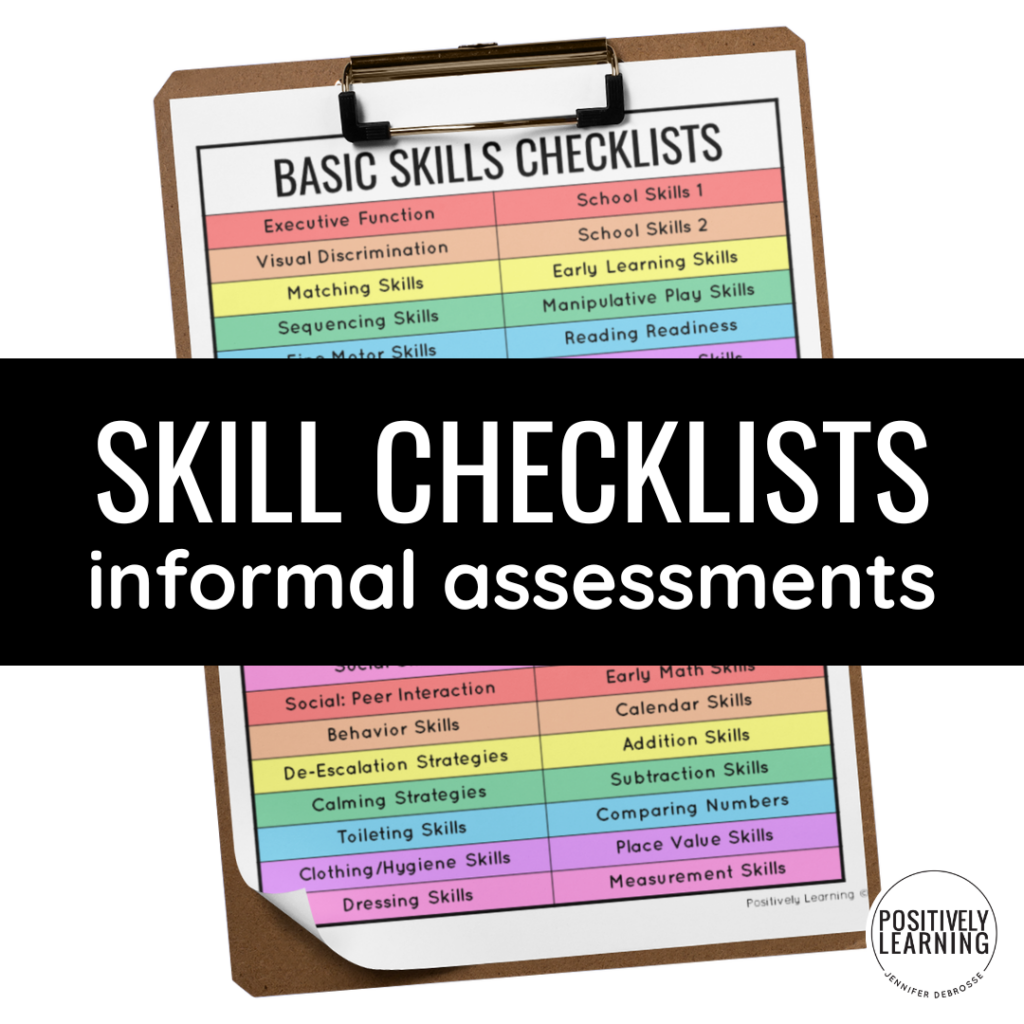
Here are some tips on how to use special education checklists as an informal assessment tool:
Monitor Progress – Monitoring student progress over time is essential when using this type of checklist as it helps identify any potential issues that may need addressing. These assessment tools can be used individually to capture a quick snapshot of a child or as a group assessment added to lesson plans. Use the suggested skills as an opportunity to check for understanding.
Collect Baseline Data – New student? No problem! These basic skills checklists are an excellent starting point to learn more about student skills and can be referred to at any point in the school year.
Use Multiple Assessments – In order to gain more accurate insight into a student’s progress, use multiple assessments such as classroom observation and class work in addition to the special education skills checklist. This approach provides more accurate data which can then be used by the IEP team when making decisions related to the student’s educational path moving forward.
Involve Parents – Involving family members or guardians in the assessment process is key when it comes to using special education basic skills checklists as they may have valuable insight into their child’s abilities or needs that could be useful when developing an individualized plan of action. Refer to the charts during a informal conference or send home to use as a flexible tool.
Keep Everything Up-to-Date – Stay ahead of the curve! It's key to assess students' abilities and make sure they reflect their current skills. Adding informal “check ins” is a great way to collect ongoing assessment data in different categories versus letting potential problem areas sneak up.

Basic Skills Checklists Features
Teacher-Friendly Assessment – these customizable checklists are editable so you can adjust benchmarks or add a new skill. No time to make adjustments? No worries – there's a “just hit print” version, too.
IEP Goals – use these reference charts as part of an informal evaluation process to determine individual needs and set realistic learning objectives.
Elementary Pre-Academic Readiness – school skill areas, work habits, steps to support independent work, and gross and fine motor (pre-writing)
Academic Skills – from reading skills and math readiness to specific early literacy and math concepts
Social Skills – peer interaction and basic communication skills are broken down into manageable steps
Life Skills – steps to support executive functioning skills, behavior skills and strategies, plus independent living (calendar skills, clothing/hygiene)

Every student is special and unique in their own way so it's important for resource teachers to have a diverse range of tools at their disposal to help them meet the needs of each individual child. These checklists are a great way to get a quick snapshot of where your students are at and what areas need improvement. With clear records documenting progress, you'll be able save time while making sure every student reaches their full potential.

Check out these checklists now and get ready to streamline your assessment process!

I'm Jennifer!
I’m Jennifer and I was a special educator in the elementary school setting over the past decade. I entered the classroom every day dedicated to making learning inclusive AND engaging.
On the Blog

In the Shop
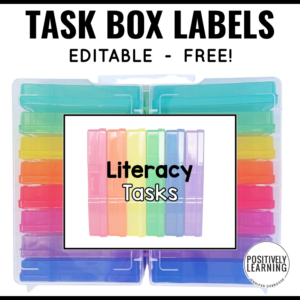
Task Boxes Free Labels for Classroom Organization

IEP Progress Report Card Comments

Classroom Routine Rubrics

- Privacy Policy
- Special Education
- Reading Intervention
- Organization
- More Topics
- Data Collection
- Teacher Gifts
- Shop on TPT
- Free-Sources
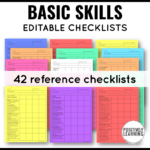
Differentiation delivered to your inbox
This website uses cookies to ensure you get the best experience on our website. See full disclosure here.
Home > Special Education & Autism Resources > Structured Learning Classroom Set-Up > Quality Guidelines Checklist for Special Education Classroom
Quality Guidelines Checklist for Special Education Classroom
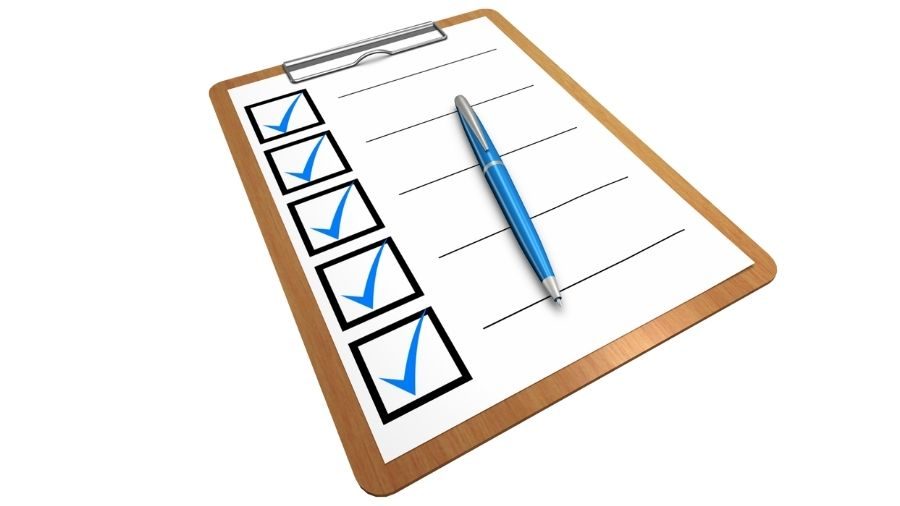
Setting up and organizing an efficient and effective special education classroom can seem like a daunting task. Tracking students’ progress towards IEP goals and Behavior Support Plan objectives, and promoting social skills all while running a smooth classroom may feel overwhelming.
If you’re looking for a resource that offers ideas and guidelines on how to accomplish all of those tasks and more, check out our quality guidelines classroom checklist !
This checklist is a very thorough and comprehensive collection of guidelines that help special education classrooms run optimally.
As you review the list, you may find that you already implement a majority of these practices and standards, but this could also be a great way to identify new approaches and additional strategies to support your students.
Check out our quality guidelines classroom checklist and adapt it to fit your classroom practices!
The special education resources on this page were authored by Watson Institute’s special education consultant, Andee Morris, M.Ed.
Quality Guidelines Checklist
If you have questions or concerns about the Watson Institute’s use of this information, please contact us .
- How can we make this resource more helpful?

5 Must-Have Checklists for Special Educators

Daily Tasks Checklist
Prioritizing what you need to get done each day is important. Just because it’s on a list doesn’t mean it’s going to be finished in a day, but using a daily task checklist will help you focus on the must-do tasks for each day. Staying focused on the most important tasks help you meet the needs of your learners without getting distracted by things that can come later (like decorating your classroom or updating lessons for next year). There is nothing like checking “done” on that daily checklist!

Always Something to Do Notes List

Beginning of the Year Checklist
There is so much to do when the school year starts! It’s easy to forget things you have to get done, teachers you have to meet with, and normal school building tasks outside your caseload paperwork. Use a beginning of the year checklist to make sure you don’t forget to complete any needed tasks. Save this one for July or August to get started before your students arrive!

Teacher Assistant Task List
If you are lucky enough to have a teacher assistant or para-educator in your room, make sure you are utilizing them to their full potential. Share the tasks you need help with on this simple teacher assistant task list . Depending on your assistant’s building role, tasks might include administrative items like making copies or laminating materials. In addition, your TA may help with student needs. Perhaps, they will assist a student with their physical, academic, or emotional needs in class while you are working with other students. Unless your assistant is attached to a specific student per the student’s IEP, your TA can work with multiple students in the class. Make sure to ask your assistant what they feel comfortable with. Utilizing their strengths when it comes to assigning them tasks will make the class run smoother for all of you!

Teacher Work Day Task List
If you are anything like me, a work day can be quickly filled with socialization and off-task behaviors. You may not have a lot of time to talk to your co-workers on a regular school day. A longer lunch and some chatting is inevitable. You can still have the social time and still get important tasks accomplished by making a teacher work day task list . Prioritize the most important things you need to get finished on your work day.

Need more organization?

Pin this for later!

Leave a Comment Cancel Reply
You must be logged in to post a comment.

Special Education Assessment Checklist [PDF Included]
Imagine you’re a teacher in a special education classroom, surrounded by students with diverse needs and abilities. You’re determined to provide each of them with the best possible education, but with so many factors to consider, it can be challenging to ensure you’re covering all your bases. That’s where the Special Education Assessment Checklist comes in.
This comprehensive guide outlines everything you need to know about conducting assessments for your special education students and provides a step-by-step process for creating an effective evaluation plan. Whether you’re a seasoned special education teacher or wondering how to become one , this post is a must-read for anyone looking to support their students and drive meaningful progress in the classroom.
This article is an essential resource for anyone looking to provide the highest level of support for their students. With its clear, concise information and practical tips, the Special Education Assessment Checklist is the perfect tool for ensuring your students are making meaningful progress in the classroom.
Why is special education assessment crucial?
Special education assessments are crucial for several reasons. Firstly, they help to identify students who require special education services and determine their specific needs. Without an assessment, it can be difficult to determine which students require additional support and what kind of support is needed.
Secondly, assessments provide valuable information for developing individualized education plans (IEPs) for each student. The IEP is a legal document that outlines the student’s strengths, weaknesses, and goals, as well as the specific accommodations and services they will receive. The IEP is developed based on the results of the assessment, so it’s important that the assessment be thorough and accurate.
Thirdly, assessments are critical for monitoring student progress. By regularly re-assessing students, teachers can determine whether they are making progress toward their goals, and make any necessary adjustments to their IEPs to ensure continued progress.
Finally, assessments provide accountability for the special education program and the school. They demonstrate that the school is meeting its obligations to provide special education services to eligible students and that these services are making a difference in the lives of students.
Therefore, special education assessments are a critical component of providing effective special education services. They help identify students who require additional support, develop individualized education plans, monitor student progress, and provide accountability for the special education program and co-teaching models .
Special education assessment checklist
1. Does the student exhibit difficulties with communication?
2. Has the student demonstrated behavioral problems in the past?
3 Is the student able to effectively interact with their peers?
4. Does the student struggle with fine motor skills?
5. Are there academic skills that require improvement?
6. Does the student have trouble maintaining attention and focus?
7. Is the student’s sensory processing developmentally appropriate?
8. Are there any concerns regarding executive functioning skills?
9. Is the student able to understand and follow directions?
10. Does the student have difficulty with self-care skills?
11. Is the student able to communicate wants and needs effectively?
12. Are there any physical limitations that impact the student’s daily life?
13. Has the student displayed problematic behavior in school settings?
14. Is the student able to form positive relationships with peers?
15. Are there any difficulties with gross motor skills?
16. Does the student require support in reading and writing?
17. Are there concerns about the student’s ability to stay on task?
18. Does the student show signs of sensory processing disorders?
19. Are there any indications of difficulties with planning and organizing?
20. Is the student able to participate in class discussions and activities?
21. Has the student had any previous disciplinary actions taken in school?

The PDF of the checklist is attached below. You can download it for free.
How to use the checklist
The Special Education Assessment Checklist can be used in the following steps:
1. Review the list: Familiarize yourself with the items on the checklist to make sure you understand what information is needed.
2. Plan the assessment: Use the checklist as a guide to plan the assessment process. Determine which assessments are needed for each student, who will conduct the assessments, and when they will be completed.
3. Conduct the assessments: Follow the plan you created and complete the assessments for each student. Make sure to gather all the information and data needed for each item on the checklist.
4. Review and analyze the results: After the assessments are completed, review the results and analyze the data. Use the information to identify each student’s strengths and weaknesses, and determine the specific services and accommodations they may need to support their learning.
5. Develop an individualized education plan (IEP): Based on the results of the assessment, create an individualized education plan (IEP) for each student. The IEP should include the student’s goals, services, and accommodations as well as a plan for monitoring progress and making adjustments as needed. Additionally, adding a plan for executing functioning skills is also necessary.
6. Implement the IEP: Once the IEP is developed, implement it in the classroom. Ensure that the student receives the services and accommodations outlined in the IEP and regularly monitor their progress to see if any adjustments are needed.
7. Evaluate and adjust: Regularly evaluate the student’s progress and adjust the IEP as needed to ensure that the student is making progress and receiving the support they need to be successful in the classroom.
The Special Education Assessment Checklist is a valuable tool for educators to support the assessment and planning process for students with special needs. By following these steps, educators can gather the information they need to develop an effective individualized education plan that meets the unique needs of each student.
Perks of using a special education assessment checklist
There are several benefits to using the Special Education Assessment Checklist, including:
1. Consistency: The Special Education Assessment Checklist provides a consistent framework for conducting assessments and evaluating students. This ensures that all students receive a comprehensive evaluation, with the same level of detail and consideration given to each student. This helps to eliminate any potential biases or inconsistencies in the evaluation process and ensures that all students receive fair and equal evaluations.
2. Efficiency: The checklist helps to streamline the assessment process, providing a comprehensive list of what needs to be evaluated. This reduces the risk of missing important information, as all necessary aspects are covered in the checklist. This saves time and resources, as all evaluations are conducted in a systematic and organised manner.
3. Collaboration: The checklist can be used by a team of educators, including teachers, special education specialists, and other support staff. This ensures that all aspects of a student’s needs are considered in the assessment process and allows for a collective and collaborative approach to making decisions about the student’s education.
4. Accurate information: The checklist helps to ensure that accurate and relevant information is gathered, which can be used to make informed decisions about the student’s educational plan. This helps to identify the student’s strengths and weaknesses, allowing for a more targeted and effective individualized education plan.
5. Better outcomes: By using a comprehensive and consistent assessment process, educators can identify the specific needs of each student and develop an individualized education plan that provides the necessary support for success. This leads to better outcomes for students with special needs, as they receive the appropriate level of support and accommodations to succeed in the classroom.
Overall, the Special Education Assessment Checklist is a valuable tool for educators to support the assessment and planning process for students with special needs, leading to better outcomes for these students.
Just like DAP Checklist , Organizational Skills Checklist , and even an inclusive classroom environment checklist , the Special Education Assessment Checklist plays a crucial role in providing the best educational experience for students with special needs. This tool allows educators to approach each student’s assessment with a personalized and diligent approach, leading to well-informed decisions about their individualized education plan.
By utilizing the checklist, educators can ensure that no aspect of the student’s needs goes overlooked, providing them with the support they require to thrive in the classroom. The use of this tool serves as a testament to the commitment of educators to providing the highest quality of education for all students, no matter their unique needs.
An engineer, Maths expert, Online Tutor and animal rights activist. In more than 5+ years of my online teaching experience, I closely worked with many students struggling with dyscalculia and dyslexia. With the years passing, I learned that not much effort being put into the awareness of this learning disorder. Students with dyscalculia often misunderstood for having just a simple math fear. This is still an underresearched and understudied subject. I am also the founder of Smartynote -‘The notepad app for dyslexia’,
Leave a Comment Cancel reply
You must be logged in to post a comment.
WELCOME! Find what you need

Elementary Math
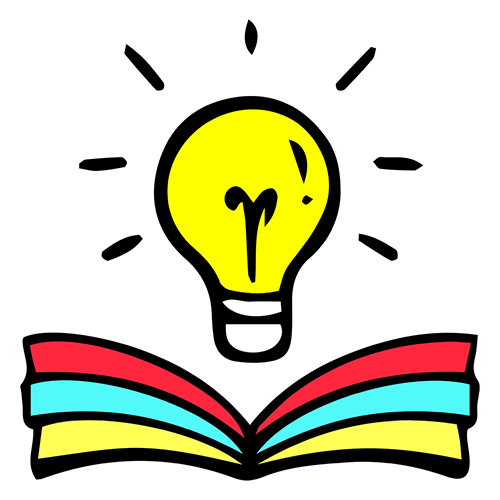
Elementary Ela-Reading


Teaching Tips

Career Exploration
Special education accommodation iep checklist for teachers.
Special education IEP checklist for teachers to track each student’s supports. Record accommodations, modifications, interventions, and supports for IEPs, 504s, and special education.
We all know the importance of supporting struggling students, at-risk learners, and special education students.
Keeping track of who gets what accommodation? That’s another story. (And if you’re confused about accommodations versus modifications, etc., click here to learn the difference!)
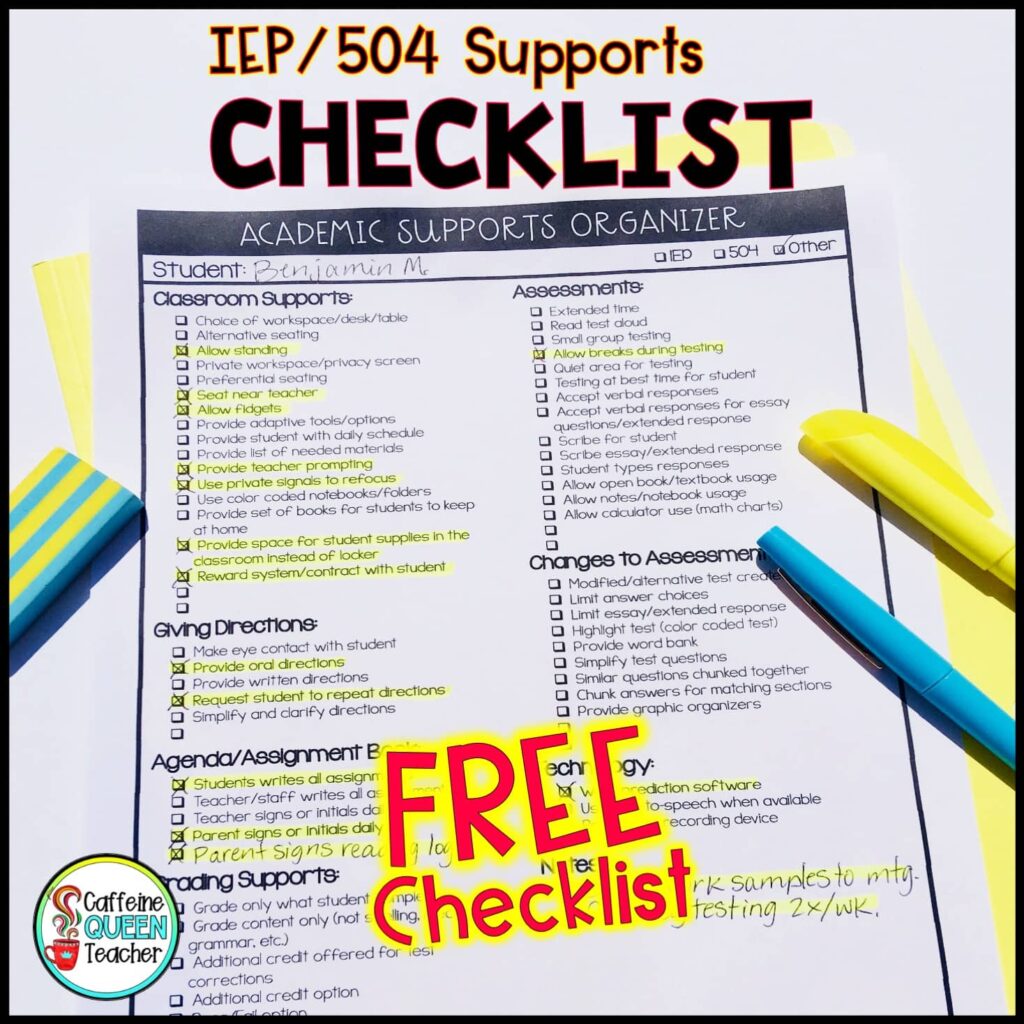
As teachers, we know it’s hard to keep track of every student’s unique needs and supports.
That’s why having a simple checklist is such an amazing time-saver !
Not only does this handy tool make organizing easier , but you’ll stay compliant with all the special education regulations for IEPs and 504 plans.
There are common accommodations available at your fingertips, plus each support is grouped into Classroom Supports , Testing , Giving Directions, etc, so everything stays neat and tidy, too.
All you need to do? Check off what each student requires – it couldn’t get much simpler than that, right?
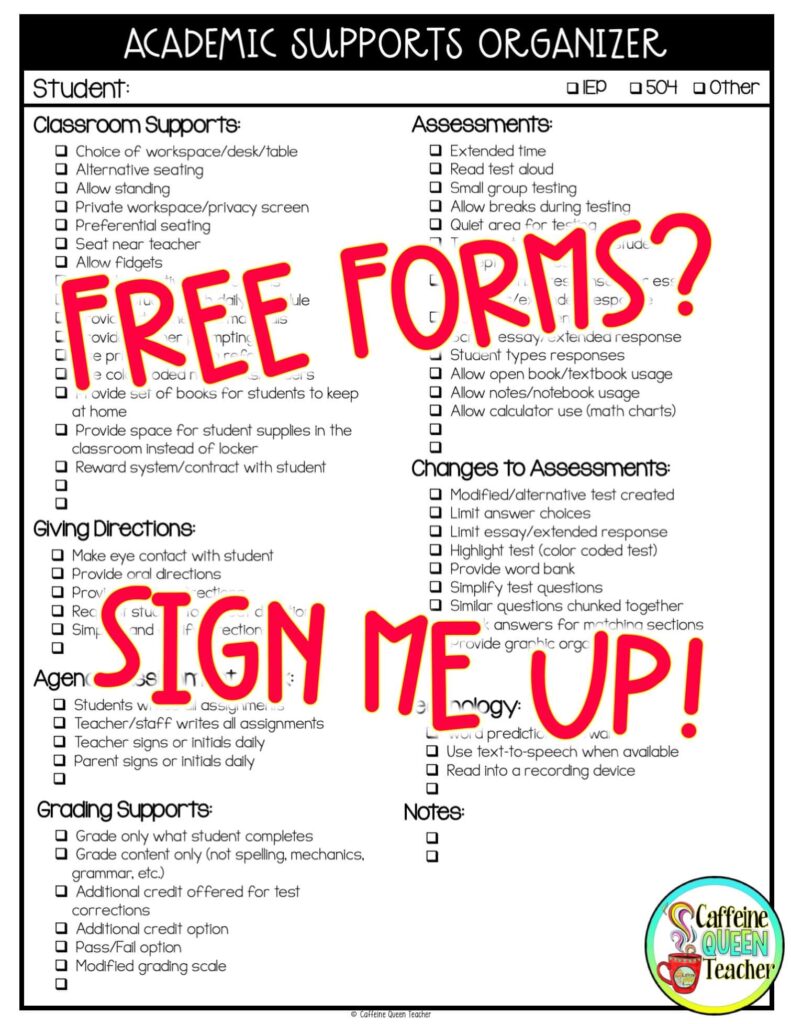
Keep your teacher binder stocked with these forms to reference during meetings, phone calls, and parent conferences. They’re also perfect for leaving with substitute teacher plans, so I keep one in my sub binder (sub tub).
These forms also make excellent reference and documentation tools during meetings because they provide a range of supports that can be discussed. Then, after the meeting, simply photocopy and distribute.
How I complete my forms:
Before the school year even begins, I fill out these essential forms for all of my students who have an IEP or 504. I store those forms in a section of my teaching binder alongside my lesson plans, grade book, and other important forms. I also stash some blank copies that I can fill out when needed during meetings with colleagues or parents.
Need to write an IEP or 504?
If you’re writing an IEP or 504, you’ll find this checklist helpful when collaborating and strategizing with teachers and parents.
How do I get this IEP checklist?
Click the picture below to grab the checklist and a few more helpful forms.
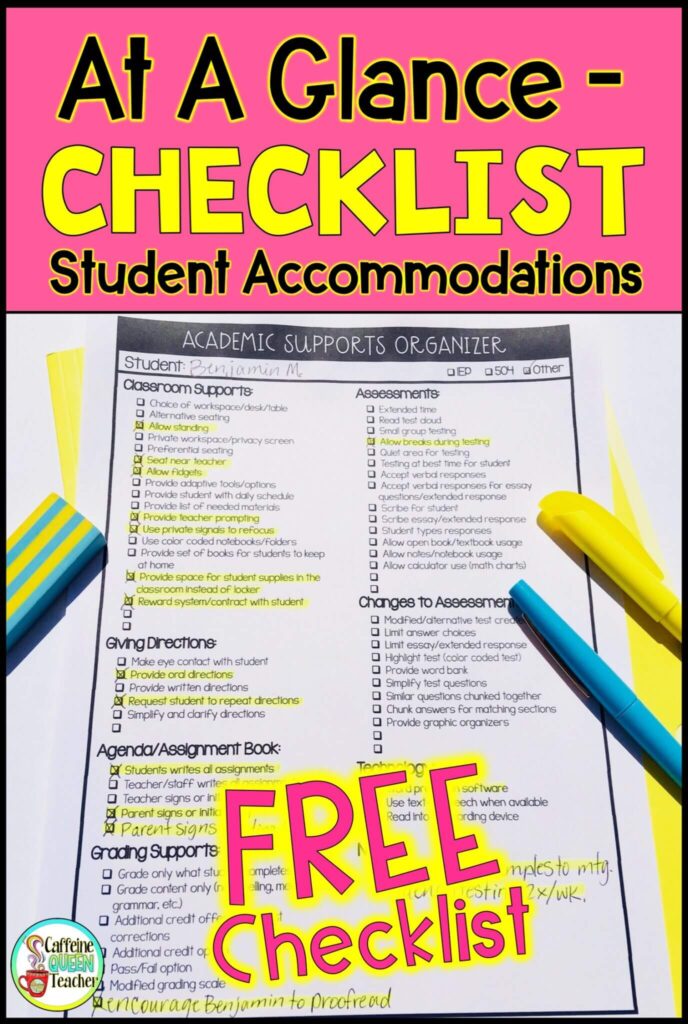
You’ll receive a teacher Organizational Form Kit with essential teaching forms FREE for joining my email newsletter list.
If you want to read more about accommodations versus modifications, etc., and grab a FREE download, click here or on the image below.
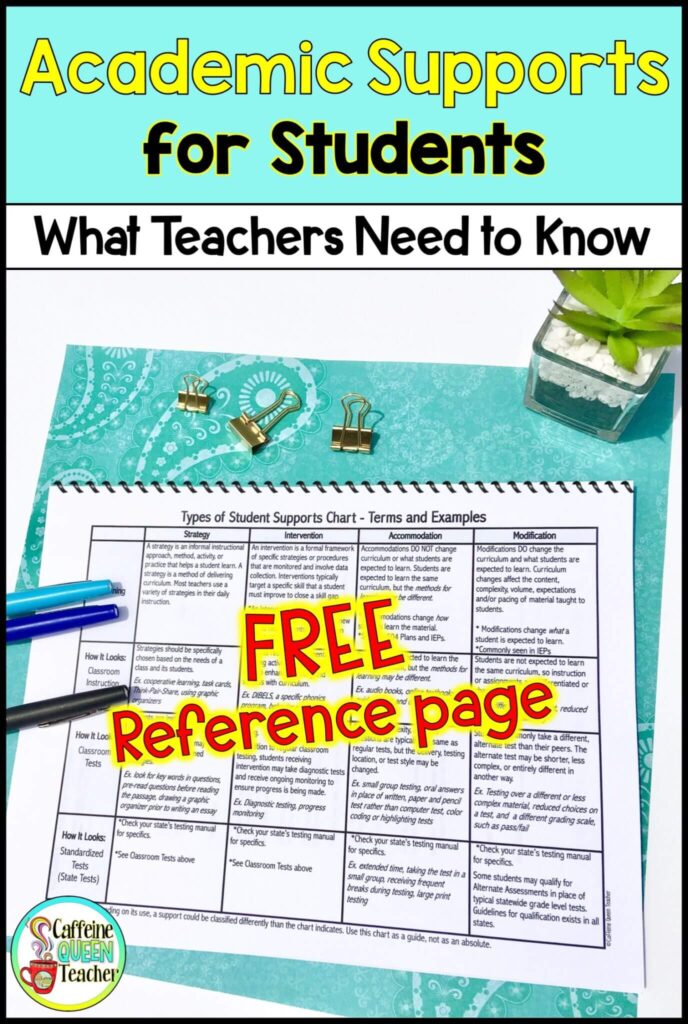
Learn about setting up Teacher Binders
Get organized using Teacher Binders

Learn about using multiplication and division accommodations with students

Learn about using text evidence to improve reading comprehension
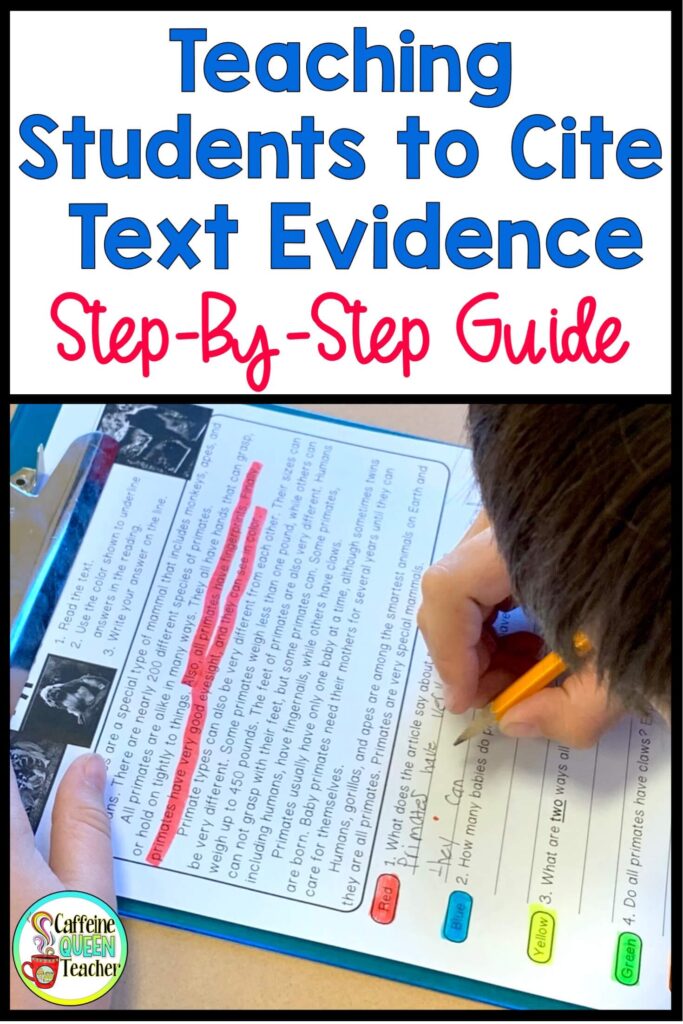
How to Teach Students to Cite Text Evidence

Hi, I’m Jules
Find it fast, browse the blog, visit my teachers pay teachers shop.


SEEK ASSISTANCE
Our Alliance
News & information, programs & services.
- Training & Resources
Special Education Eligibility Checklist
This document provides a broad overview of the eligibility process, describes how to read assessments, and outlines the criteria for the most common eligibilities..
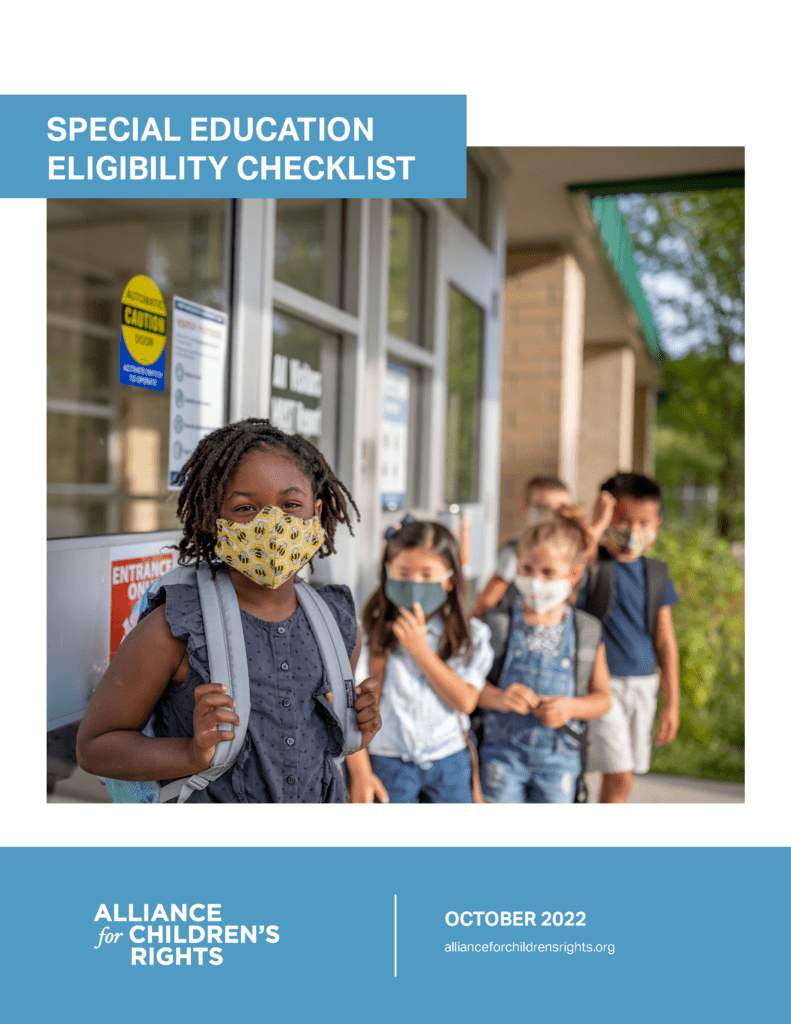
Last updated 2018: Federal law identifies 13 eligibility categories, including an optional eligibility for developmental delays for students ages 3 through 9. The prevalence of the students being served under each eligibility category varies widely and changes over time.
- View Other Resources
The Alliance for Children’s Rights protects the rights of impoverished, abused and neglected children and youth.
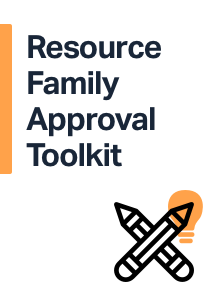
Sign up to join the Alliance and stay connected to the work we’re doing in response to the needs of children, young adults, and families impacted by the child welfare system.

Alliance for Children’s Rights is a 501(c)(3) not-for-profit organization. EIN number 95-4358213. © 2020 Alliance for Children’s Rights Privacy Statement Terms and Conditions Accessibility
Privacy Overview
The Edvocate
- Lynch Educational Consulting
- Dr. Lynch’s Personal Website
- Write For Us
- The Tech Edvocate Product Guide
- The Edvocate Podcast
- Terms and Conditions
- Privacy Policy
- Assistive Technology
- Best PreK-12 Schools in America
- Child Development
- Classroom Management
- Early Childhood
- EdTech & Innovation
- Education Leadership
- First Year Teachers
- Gifted and Talented Education
- Special Education
- Parental Involvement
- Policy & Reform
- Best Colleges and Universities
- Best College and University Programs
- HBCU’s
- Higher Education EdTech
- Higher Education
- International Education
- The Awards Process
- Finalists and Winners of The 2023 Tech Edvocate Awards
- Award Seals
- GPA Calculator for College
- GPA Calculator for High School
- Cumulative GPA Calculator
- Grade Calculator
- Weighted Grade Calculator
- Final Grade Calculator
- The Tech Edvocate
- AI Powered Personal Tutor
Teaching Students About Mug Shots: A Valuable Lesson in Civics and Law Enforcement
Teaching students about family words list, thank you messages for gift, teaching students about the downton abbey film: bringing history to life, teaching students about the league cup: a comprehensive guide, teaching students about negative heat in endothermic and exothermic reactions, teaching students about the school of athens: enlightening the minds of tomorrow, teaching students about girona: a cultural and historical adventure, teaching students about donald trump’s wiki page: a comprehensive resource, teaching students about the oldest hockey team, create an effective special education classroom with these checklists.
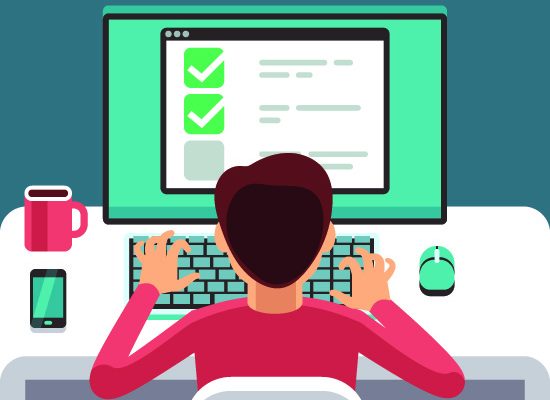
There are several strategies that a special education teacher can implement in the classroom to help students who have special needs. It is better to use a multi-modal approach to assist visual, kinesthetic, tactile, and auditory learners.
Classroom Environment
- Make the student sit in a place where there are no distractions.
- Reduce the number of visual distractions.
- Remove unnecessary things from the pupil’s desk, so there is less distraction.
- Whenever necessary, provide a study carrel to the student.
- Keep extra pens, pencils, paper, and books in the room.
- Provide a checklist so that the student can stay organized.
- Decide a cue to indicate that the student can leave the room.
- If necessary, allow the student to have frequent breaks.
- Offer a suitable peer role model.
- Avoid power struggles and confrontations.
- Decide on a safe place where the student may go.
- Modify the rules that are not suitable for students with neurological disorders.
- If the class is not disturbed by particular attention-seeking behavior, ignore it.
- Develop some signs or codes to make the student aware that their behavior is not right.
- Make a code of conduct for the classroom. Display it so that all the students know about it.
- Provide instant reinforcement and feedback.
- Develop a realistic behavior intervention plan.
Presentation of Study Materials
- Provide alternative assignments instead of lengthy written assignments.
- Break down the assignments into shorter tasks.
- Break the lengthy assignments into short sequential steps and monitor each step.
- Modify expectations according to the student’s needs.
- If possible, provide verbal and written directions with visuals.
- Provide a sample of the final product.
- In every task, number and arrange the steps in a sequence.
- Highlight the key points when you give written directions for an assignment to make the student focus on them.
- Provide study guides, outlines, and copies of class notes.
- Before you begin a lesson, make sure the student is attentive and explain the learning expectations.
- Allow them to use computers, calculators, tape recorders, and dictation.
- Check the homework assignments and sign them. Also, ask the parents to sign them.
Time Management
- Let them work for a short period, then give them a break.
- Fix a place for submitting assignments.
- Give extra time to complete their assignments and homework.
- Give several reminders before you change to another activity.
Assessment and Grading
- If possible, exempt them from district level testing.
- Let them sit in a quiet place while writing a test.
- Allow them to give oral responses.
- Break down the test into short sections.
- Give them sufficient time according to their need to complete the test.
- Grade the spelling and content separately.
- Change the amount of work needed for passing.
- As far as possible, do not give a time test.
- Allow them to retake the test.
It is a challenging task to teach in a classroom full of students with special needs. However, if you implement the strategies listed above, you can offer a suitable learning environment for all the students irrespective of their learning aptitude.
How to Help Your Learners Develop a ...
A guide to didactic materials.
Matthew Lynch
Related articles more from author.

The Edvocate Podcast, Episode 1: 8 Attributes of Successful Digital Age Teachers

Apraxia Apps, Tools, and Resources That We Love

Does Tutoring Truly Bring Value to Learning?

ADA (Americans with Disabilities Act): Everything You Need to Know

10 Special Education and Gifted and Talented Education Conferences You Don’t Want to Miss in 2019

Individualized Family Service Plan (IFSP) : Everything You Need to Know
What is Special Education?
Special Education is a set of services provided to students who experience exceptional learning needs. Governed by federal law ( Individuals with Disabilities Education Act, IDEA ), special education is defined as: “Specially designed instruction, at no cost to parents, to meet the unique needs of a child with a disability.” Special education services may be provided across a variety of educational environments to students who have an individualized education program (IEP).
Eligibility for special education services requires that students have an identified disability that impacts their ability to learn and requires additional services and resources to effectively participate in school. Children who typically qualify for special education services include those with the following disabilities:
- Intellectual disability
- Hearing impairments (including deafness)
- Speech or language impairments
- Visual impairments (including blindness)
- Serious emotional disturbance
- Orthopedic impairments
- Autism spectrum disorder
- Traumatic brain injury
- Other health impairments
- Specific learning disabilities
- Developmental delay
Under the law, the IDEA ensures that regardless of a student’s disability or level of severity, schools must provide an appropriate education to ALL children with a disability (ages 3-21). It also requires that the following six principles be provided for students who receive special education services:
- Free and Appropriate Public Education (FAPE) — a public education at no cost to parents/guardians or children designed to meet the individual needs of each student, provide access to the general education curriculum, provides services in accordance to a student’s IEP, and results in an educational benefit to the child.
- Nondiscriminatory Identification and Evaluation — refers to the process and instruments used to identify individuals with a disability. Schools are required to use nonbiased methods as well as multiple approaches in the evaluation process to ensure that there is no discrimination on the basis of race, culture, or native language. All evaluation instruments must use the child’s first language. No identification or placement decisions may be based on a single evaluation instrument or test score.
- Individualized education program (IEP) — this document is the foundation of special education and specifically describes the services to be provided to the student with a disability. The IEP includes a description of a student’s current level of educational performance, information on how his or her disability influences academic performance, and details needed adaptations and accommodations. This document also specifies the educational settings in which the student will receive instruction in the least restrictive environment, the learning goals and objectives that will be addressed within a targeted year, behavior management plan (if needed), transportation needs, and related services.
- Least Restrictive Environment (LRE) — this indicates the educational settings in which a student with a disability receives special education services. The assumption is that all children will be educated alongside their peers without disabilities, to the greatest extent appropriate. It is only when it is determined that a student’s education cannot be achieved satisfactorily using supplemental aids and services in general classroom settings that alternative educational settings would be identified. At that time, the LRE might include special education services received part- or full-time in a resource room setting, a self-contained classroom setting, and/or community-based settings.
- Parent Participation — parents of a child with a disability must be a member of any group that makes decisions regarding the placement and LRE of their child. Parents have a right to notification of all meetings regarding their child’s placement, access to planning and evaluation materials, and notification of any planned evaluations. Both parents and students must be invited to attend IEP meetings.
- Due Process Safeguards — these include the protections afforded to children and their parents under IDEA. Safeguards include: obtaining parental consent for all evaluations and educational placement decisions, confidentiality of all records relating to a child with a disability, independent student evaluation at public expense, and due process hearings when the school and parent may disagree.
If you are ready to make a difference as an educator and learn new ways to nurture a modern classroom, earn your online Master of Science in Education in Special Education from Purdue University. Within this convenient online platform, you can reach your goals of higher education at an accelerated pace. Call 877-497-5851 to speak with an admissions advisor.

In order to continue enjoying our site, we ask that you confirm your identity as a human. Thank you very much for your cooperation.
Who’s Eligible for Special Education Services? Schools Struggle to Keep Up

- Share article
Hayden Gilmore walked across the stage to receive his diploma in 2022 along with the rest of his peers. But unlike most of them, he returned to school for two more years after that.
That’s because Hayden, 20, is on the autism spectrum and struggles with anxiety. In his home state of Pennsylvania, students who have disabilities are eligible to remain in public schools and receive services tailored to their individual needs until the end of the school year in which they celebrate their 21st birthday.
“There’s a lot of people that don’t realize that you can stay after 18,” said Janette Gilmore, Hayden’s mother. “I wouldn’t have even known it either if I didn’t have a network of people” whose children were in similar situations.
Federal law dictates that students with disabilities are eligible to remain in school for as long as the school offers educational programs like community-college pipelines and GED preparation courses to adult students without disabilities. That means students who reach graduation age but aren’t yet ready to move on from the services they routinely receive at school can continue to attend for a few more years.
This little-known requirement for school districts provides a crucial lifeline for families with students who may benefit from additional time in the familiar environment of the school building before transitioning to whatever’s next, whether it’s college, a career, or another supportive program.
But it can also create headaches and confusion for school district administrators scrambling to budget for complex and costly mandatory services; for special education teachers and aides aiming to provide individualized support for students with varied needs; and for parents tasked with figuring out their children’s rights.
The maximum eligibility age for special education services varies from one state to the next. Courts have recently compelled schools in some states to offer services to students for longer periods of time. Costs for special education services have skyrocketed in many places, meanwhile, even as state and federal funding for those services has stayed flat or even declined. And some states lack the resources and infrastructure to support people with disabilities as they transition out of the K-12 system.

Educators from districts that intentionally prioritize older students’ unique needs say such programs have a transformative impact on their social and economic prospects after high school.
“The benefits for each student can look quite different, but some tangible ones are the social opportunities, the ability to make connections within the community, look for those competitive employment opportunities, and prepare for as much independence as possible,” said Kathryn Romero, director of student services in the Barrington, Ill., district, where students with disabilities can continue their education through the school year in which they turn 22.
Shifts in special education policy can be abrupt and confusing
As with so many policies governing American education, states differ on the maximum age at which students can receive special education services.
Since 2021, at least nine states have shifted the maximum age to 22: Connecticut , Hawaii , Illinois , Maine , Minnesota , Pennsylvania , New York , Rhode Island , and Washington . Most of those states now require services through the student’s 22nd birthday or the day before, though Illinois requires schools to offer services through the end of the school year during which the student turns 22.
That shift has happened in large part because of a growing legal consensus that the Individuals with Disabilities Education Act requires schools to offer special education services to students until they turn 22. The law is ambiguous on the specific requirements and has been subject to varied interpretations since it took effect half a century ago.
The failure to extend those offerings can be costly. Hundreds of former students in Hawaii reached a $10.25 million settlement with the state in 2018 over allegations that older students with disabilities lacked access to educational opportunities that students without disabilities had.
The situation in Pennsylvania has been particularly complicated in recent years.
In August 2023, shortly before the school year began, the Pennsylvania Department of Education announced that the state’s schools must extend special education services to students until their 22nd birthday. The decision stemmed from the settlement of a federal class action lawsuit filed by a 19-year-old student with disabilities and his parents.
Three school districts filed a lawsuit a few weeks later challenging the rule change, arguing the department didn’t give them enough time to weigh in.
On May 16, a court sided with the districts and temporarily halted the age-22 eligibility , which meant students were once again eligible through the end of the school year when they turned 21.
But four days later, the policy changed yet again, when the state education department informed districts that a court had restored the age-22 eligibility rule in response to the department’s latest appeal, according to an email to district leaders from the department obtained by Education Week.
Last year’s initial policy change was already jarring for districts and families. Kirsten Scheurich, director of special education for the Hershey district, spent four days last September frantically calling parents whose children had left at the end of the previous school year to see if they wanted to return until their 22nd birthday.
In the last month, she’s made two more rounds of calls to parents keeping them up to date on the latest developments.
“We feel like we’re calling parents to say, ‘You can stay, no you can’t, yes you can,’” Scheurich said. “Parents are just like, ‘What is going on?’”
In her district, only one student chose to return as a result of the eligibility extension.
But in some neighboring districts, Scheurich said, numerous students came back, leading districts to spend hundreds of thousands of unbudgeted dollars on out-of-school placements for returning students.
Those unexpected costs add to an already substantial burden many districts shoulder in their legally mandated effort to provide special education to students with disabilities. Federal funding covers less than 15 percent of special education expenses nationwide, and many states shift the onus to school districts to make up the difference.

Additional services for older students with disabilities can be costly
In Illinois, as in Pennsylvania, the increased age limit for services came without an accompanying stream of new state funding.
In a graduating class of roughly 1,000 students, as few as 20 might choose to stay in a given year, said Melissa Taylor, assistant superintendent for student services for the 3,400-student Belleville district. But the cost of services for those students adds up quickly.
Some students in the Belleville district opted to stay in cooperative programs or private facilities for which daily tuition bills can be many times costlier than the district’s average per-pupil investment.
We feel like we’re calling parents to say, 'You can stay, no you can’t, yes you can. Parents are like, 'What is going on?'
“If you have a student whose birthday happens to fall on Sept. 1, they now are finishing out that school year, and so that can be a hefty burden on a school district that wasn’t planning for that,” said Taylor, who also serves as executive director of the Illinois Alliance of Administrators of Special Education.
The abrupt expansion of special education eligibility also forced the district to quickly investigate whether teachers were certified to serve 22-year-old students, as many teachers are not. Taylor had to collaborate with the district’s private provider partners to ensure their paperwork matched the evolving state mandates.
“We went through a little panic that we would have kids who would lose placements because the schools were only approved through age 21,” Taylor said.
Thankfully, though, “those things have not happened.”
Many families don’t know additional time is an option
Conversations about the post-high school transition for K-12 students with disabilities can start as early as age 14. Parents and school district representatives, sometimes with the help of lawyers and consultants, weigh the options for what the student will prefer to do and be capable of doing once they reach graduation age—whether it’s college, the workforce, vocational rehabilitation, or home care, among other options.
This process can be a learning experience for everyone involved. Sometimes families don’t even realize keeping the child in school past age 18 is an option, said Audrey Trainor, an associate professor of special education at New York University.
“It really is dependent on whether the professionals are highly aware, highly organized, coordinating together,” Trainor said. “You can imagine across institutional services, it can be challenging.”
Some district administrators worry that tying a student’s eligibility to their birthday creates jarring situations for students who have to leave school mid-year.
“If you had an Oct. 1 birthday, you were able to start the school year and then all of a sudden, on your birthday, you’re no longer able to come back,” said Romero, in Illinois.
In 2021, Illinois lawmakers passed legislation that allows students to continue receiving services through the school year in which they turn 22, rather than being cut off on their birthday.
The abrupt cutoff “makes it very, very difficult, especially in terms of trying to ensure that we are helping families and students connect with the right adult services and supports beyond what can be offered through the public school,” Romero said.
Arranging the post-high school future for students can also be tricky if state agencies tasked with providing support to adults with disabilities haven’t adjusted to the possibility of new entrants to the system year-round, Taylor said. That’s more likely to happen if students age out of the school system after their birthday, as opposed to the end of the academic year.
An even steeper challenge for recent high school graduates with disabilities comes when they try to access state-offered services. Hundreds of thousands of people nationwide are on waitlists for disability services from overburdened and underfunded state agencies.
Hayden and his family started discussing his post-graduation plans when he was in 9th grade, his mother said. Especially with the onset of the pandemic happening during his time in high school, they ultimately agreed he would do best with more time in school.
He ended up staying two years. This coming school year, the last one he’s eligible to attend in full, he’s joining the Project Search program, which helps connect students with disabilities to local professional opportunities. Next year, instead of going to school, Hayden will participate in an internship at the Hershey Medical Center.
Leaving school the day after his January birthday would have been hard for Hayden, his mother said.
Especially with the ongoing policy turbulence around these services, Gilmore believes parents of children with disabilities need to help each other out.
“You’ve got to be involved, network a little bit, find someone that may be a few years ahead of you,” Gilmore said. “It just helps.”

Maya Riser-Kositsky, Librarian and Data Specialist contributed to this article.
Sign Up for EdWeek Update
Edweek top school jobs.

Sign Up & Sign In

NASET.org Home Page
Exceptional teachers teaching exceptional children.
- Overview of NASET
- NASET Leadership
- Directors' Message
- Books by the Executive Directors
- Mission Statement
- NASET Apps for iPhone and iPad
- NASET Store
- NASET Sponsors
- Marketing Opportunities
- Contact NASET
- Renew Your Membership
- Membership Benefits
- Frequently Asked Questions
- Membership Categories
- School / District Membership Information
- Gift Membership
- Membership Benefit for Professors Only
- NASET's Privacy Policy
- Forgot Your User Name or Password?
- Contact Membership Department
- Resources for Special Education Teachers
- Advocacy (Board Certification for Advocacy in Special Education) BCASE
- Board Certification in Special Education
- Inclusion - Board Certification in Inclusion in Special Education (BCISE) Program
- Paraprofessional Skills Preparation Program - PSPP
- Professional Development Program (PDP) Free to NASET Members
- Courses - Professional Development Courses (Free With Membership)
- Forms, Tables, Checklists, and Procedures for Special Education Teachers
- Video and Power Point Library
- IEP Development
- Exceptional Students and Disability Information
- Special Education and the Law
- Transition Services
- Literacy - Teaching Literacy in English to K-5 English Learners
- Facebook - Special Education Teacher Group
- NASET Sponsor's Products and Services
- ADHD Series
- Assessment in Special Education Series
- Autism Spectrum Disorders Series
- Back to School - Special Review
- Bullying of Children
- Classroom Management Series
- Diagnosis of Students with Disabilities and Disorders Series
- Treatment of Disabilities and Disorders for Students Receiving Special Education and Related Services
- Discipline of Students in Special Education Series
- Early Intervention Series
- Genetics in Special Education Series
- How To Series
- Inclusion Series
- IEP Components
- JAASEP - Research Based Journal in Special Education
- Lesser Known Disorders
- NASET NEWS ALERTS
- NASET Q & A Corner
- Parent Teacher Conference Handouts
- The Practical Teacher
- Resolving Disputes with Parents Series
- RTI Roundtable
- Severe Disabilities Series
- Special Educator e-Journal - Latest and Archived Issues
- Week in Review
- Working with Paraprofessionals in Your School
- Author Guidelines for Submission of Manuscripts & Articles to NASET
- SCHOOLS of EXCELLENCE
- Exceptional Charter School in Special Education
- Outstanding Special Education Teacher Award
- Board Certification Programs
- Employers - Job Posting Information
- Latest Job Listings
- Professional Development Program (PDP)
- Employers-Post a Job on NASET
- PDP - Professional Development Courses
- Board Certification in Special Education (BCSE)
- Board Certification in IEP Development (BCIEP)
- NASET Continuing Education/Professional Development Courses
- HONOR SOCIETY - Omega Gamma Chi
- Other Resources for Special Education Teaching Positions
- Highly Qualified Teachers
- Special Education Career Advice
- Special Education Career Fact Sheets
- FAQs for Special Education Teachers
- Special Education Teacher Salaries by State
- State Licensure for Special Education Teachers
- Child Study Team
• Child Study Team Checklist for Initial Student Review
• Child Study Team Pre-Referral Strategies Checklist
• IEP Committee Packet Checklist
• Obtaining School Records on a Student-Checklist
• Student Observation Checklist
• Suggested Intervention Options of the Child Study Team Used Prior To Evaluation Form
• Structured Student Observation Checklist
• Initial Referral to the MDT from the School Staff
• Open Ended Referral Form
• Social Developmental History Form
• Structured Referral Form
• Unstructured Student Observation Form
If you are a member of NASET , you may access these Checklists and Forms by using the membership login.
If you would like to be a member and access all that NASET has to offer, use this link - JOIN NASET
- Adapting the Curriculum
- Child Development Information
- Classroom Management
- Identification of High Risk Students or Special Needs Students
- IEP (Individual Education Program)
- IEP Committee
- Medical Information
- Related Services Forms
- Suspected Abuse and Neglect
- Working With Parents
- Working with Staff
©2024 National Association of Special Education Teachers. All rights reserved

IMAGES
VIDEO
COMMENTS
NASET's Forms, Tables, Checklists, and Procedures provides NASET members with a comprehensive resource of materials that can be accessed for practical everyday issues faced by special educators. Simply click on the main heading of any of the sections below and it will take you to various types of materials to review and potentially use both in ...
National Association of Special Education Teachers NASET | Structured Student Observation Checklist 2 C. At the End of Assigned Time, the Student: _____Completes task _____Takes pride in completed task _____Goes on to next task _____Refuses to complete task SOCIAL INTERACTION The Student:
If you are a member of NASET, you may access these Checklists, Forms, Tables, and Procedures by using the membership login. If you would like to be a member and access all that NASET has to offer, use this link - JOIN NASET. To top. Special Education Web Site - Teachers Teaching Special Education National Association of Special Education ...
DOMAIN II: STUDENT UNDERSTANDING Standard 3: The teacher assists students in self-regulation and monitors generalization of learning Revised 2/2021 Special Education Observation Form } 4 Indicators 4 • Regularly opens the lesson with a clear introduction and review, model of skills and cognitive strategies, and/or provides clear explanation of concepts, depending on where the teacher is in a ...
The above are simply suggestions to help you in the set up of your special education classroom. Feel free to get creative and make your own checklist with areas that work best for you and your students! The special education resources on this page were authored by Watson Institute's special education consultant, Lisa Plastino, M.Ed.
Here are some tips on how to use special education checklists as an informal assessment tool: Monitor Progress - Monitoring student progress over time is essential when using this type of checklist as it helps identify any potential issues that may need addressing. These assessment tools can be used individually to capture a quick snapshot of a child or as a group assessment added to lesson ...
> Identify need for special education and related services and basis for determination using current eligibility criteria; ... > For students with low incidence disabilities, discuss need for specialized materials and/or equipment; > Be well written, signed, dated and page numbered, translated into parent's primary language, if necessary; ...
Quality Guidelines Checklist for Special Education Classroom. Setting up and organizing an efficient and effective special education classroom can seem like a daunting task. Tracking students' progress towards IEP goals and Behavior Support Plan objectives, and promoting social skills all while running a smooth classroom may feel overwhelming.
Meet with special teachers to help plan co-taught lessons for your students. Go through lesson files to decide what to use again next year and what to discard. Apply for grants or Donors Choose projects to support your students' needs. Make positive phone calls home to parents.
How to use the checklist. The Special Education Assessment Checklist can be used in the following steps: 1. Review the list: Familiarize yourself with the items on the checklist to make sure you understand what information is needed. 2. Plan the assessment: Use the checklist as a guide to plan the assessment process. Determine which assessments are needed for each student, who will conduct the ...
Special education IEP checklist for teachers to track each student's supports. Record accommodations, modifications, interventions, and supports for IEPs, 504s, and special education. We all know the importance of supporting struggling students, at-risk learners, and special education students.
The student teacher: a special education credential candidate who has been cleared to student teach by the Credential Office; may be traditional or on-the-job. 2. The cooperating teacher (traditional) or on -site support provider (on the job): ... Preparing for Special Education Student Teaching • A checklist for getting started
SPECIAL EDUCATION STUDENT TEACHER EVALUATION CHECKLIST . While the general education student teaching semester provides the student teacher with many varied experiences, the student teaching experience in a special education setting often includes a number of opportunities unique to special education. Whether at an elementary, middle school or ...
Special Education Eligibility Checklist. This document provides a broad overview of the eligibility process, describes how to read assessments, and outlines the criteria for the most common eligibilities. Last updated 2018: Federal law identifies 13 eligibility categories, including an optional eligibility for developmental delays for students ...
Confirm that no more than 40% of the students in an ICT class have IEPs (up to a maximum of 12 students with IEPS in the class). Note: All students with IEPs, including those recommended for general education with related services only, count towards the maximum of 12 students (or 40%) in the ICT class. *All ICT and Special Classes must begin
Spread the loveThere are several strategies that a special education teacher can implement in the classroom to help students who have special needs. It is better to use a multi-modal approach to assist visual, kinesthetic, tactile, and auditory learners. Classroom Environment Make the student sit in a place where there are no distractions. Reduce the number of visual distractions. Remove ...
Discover the ultimate beginning of the year checklist for Special Education teachers, designed to create a strong foundation for student success. From inclusive classroom setups to individualized learning plans, this comprehensive checklist ensures a magi ... As the student's Special Education case manager or liaison, it is your ...
Equipping your special educators with expert IEP best practice tips helps novice and veteran educators build and implement multi-dimensional IEPs that enable a student to make appropriate progress. This IEP Checklist , based on advice from special education expert Carol Kosnitsky, outlines best practices and how they help ensure a Free ...
Observing children at play can tell us a great deal about self esteem, tension levels, social maturity, physical development, and many other factors. Social interaction is more common in children over the age of 6 or 7 while parallel play is still common in younger children. Appropriate social interaction gives us insight into the child's own ...
Preliminary Special Education Credential Program Checklist (Early Childhood, Mild Moderate, Extensive Supports (Formally Moderate Severe) (657) 278-4196 Step 1: Apply to Program NOTE: You MUST have already completed the pre-requisites OR are currently taking the pre-requisites in order to apply to the program. Priority Deadlines:
Special Education is a set of services provided to students who experience exceptional learning needs. Governed by federal law (Individuals with Disabilities Education Act, IDEA), special education is defined as: "Specially designed instruction, at no cost to parents, to meet the unique needs of a child with a disability." Special education services may be provided across a variety of ...
Checklists. • Alternate Learning Activities Checklist. • Beginning of School Checklist-Getting to Know Your Students. • Learning Styles Classroom Assessment. • Mainstreaming Checklist. • Multiple Intelligences Inventory. • Possible Occupational Therapy Services Checklist. • Teacher Checklist of Classroom Characteristics.
As a member, you'll also get unlimited access to over 88,000 lessons in math, English, science, history, and more. Plus, get practice tests, quizzes, and personalized coaching to help you succeed.
If you are a member of NASET, you may access these Tables by using the membership login. If you would like to be a member and access all that NASET has to offer, use this link - JOIN NASET. To top. Special Education Web Site - Teachers Teaching Special Education National Association of Special Education Teachers.
In August 2023, shortly before the school year began, the Pennsylvania Department of Education announced that the state's schools must extend special education services to students until their ...
Checklists. • Child Study Team Checklist for Initial Student Review. • Child Study Team Pre-Referral Strategies Checklist. • IEP Committee Packet Checklist. • Obtaining School Records on a Student-Checklist. • Student Observation Checklist. • Suggested Intervention Options of the Child Study Team Used Prior To Evaluation Form.